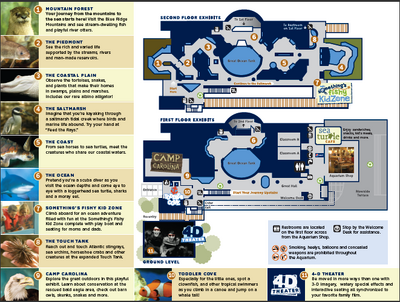
Map
The South Carolina Aquarium, located in Charelstion, South Carolina, opened in May 2000 on the historic Charleston Harbor. It is home to over 10,000 plants and animals. The largest exhibit in the Aquarium is The Great Ocean Tank, which extends from the first to the third floor of the Aquarium; it holds over 385,000 gallons of water and contains over 300 animals.
| Date opened | May 19, 2000 |
|---|---|
| Location | Charleston, South Carolina,USA |
| Number of animals | 10,000+ |
EXHIBITS
Great Hall: The Great Hall is the impressive introduction to the South Carolina Aquarium. Two-story windows offer one of the best views in town of Charleston Harbor. A large wall map of South Carolina allows visitors to see the regions of South Carolina represented in the Aquarium. The floor is an artistic representation of the entire coast of South Carolina from the North Carolina to the Georgia border.. The 15,000 gallon Carolina Seas exhibit that is the centerpiece of the Great Hall allows guests to see some of the colorful fish found around the reef habitats off the coast of South Carolina. Fish featured here are Nurse Sharks, Lookdowns, Spanish Hogfish, Green Moray eel and many more.
Mountain Forest: The Mountain Forest Aviary is a journey into some of the habitats found in the Blue Ridge Mountains of South Carolina. Visitors to the aviary walk through a space where spectacular waterfalls cut through rocky gorges while the trees above form a canopy to shelter several species of songbirds. In the water, stream-dwelling fish, such as the three species of freshwater trout found in South Carolina, can be seen swimming below the cascades. Under the largest waterfall, two young North American river otters can be seen playing. There are also Northern Cardinals, and Brook trouts.
Piedmont: The Piedmont Gallery explores the varied life supported by the streams, rivers and man-made reservoirs of South Carolina’s Piedmont region. Many fish, such as bass, crappies and suckers, can be seen swimming in exhibits that display their natural habitats. Other exhibits demonstrate the science behind fly-fishing and give a peek into what South Carolina was like in prehistoric times, with a chance to find out what a saber-tooth tiger’s teeth and a giant ground sloth’s claws feel like. There is also Fleryblack shiners, Robust Redhorse, Greater Sirens, and Redear sunfish.
Coastal Plain: The Coastal Plains Gallery allows you to discover the fish, reptiles, amphibians and plants found in South Carolina’s Coastal Plain region. Wetland habitats such as brownwater swamps, Carolina Bays and freshwater marshes all can be seen in this gallery. The blackwater swamp exhibit contains remnants of cypress trees that were felled by Hurricane Hugo in 1989, and special effects that replicate the sights, sounds and atmosphere of a swamp at twilight. The Coastal Plain Gallery also displays some of South Carolina’s most interesting predators such as Eastern Diamondback rattlesnakes, Longnose gar and the Venus Flytrap. Ther is also Spotted softshell turtles, Bluegills, and American Alligators.
Coast: The Coast Gallery displays some of the animals who live under the water along South Carolina’s coastline. Fish living in Charleston Harbor, such as Lined sea horses, Southern flounder and stingrays, can be seen in the Coast Gallery’s exhibits. Other exhibits test the visitor’s knowledge of shells, show just what is making those holes in the sand on the beach and let visitors see how local shrimpers help to protect sea turtles. See how your breath-holding skills match up against those of a Loggerhead sea turtle, and view live video from our sea turtle rescue hospital. Also see a Common Octopus, Slender pipefish, and Atlantic stingrays.
Ocean: The Ocean Gallery allows visitors to see the varied habitats found in the ocean off the coast of South Carolina. The centerpiece of this gallery is the massive, two-story Great Ocean Tank which holds 385,000 gallons of salt water and contains hundreds of animals, including Sandbar and Sand tiager sharks, Pufferfish and a Loggerhead sea turtle that weighs over 280 pounds. Other exhibits display Moon jellyfish, colorful reef fish like the Short Bigeyes and Ocean Surgeonfish and live baby sharks developing within their egg cases.
Touch Tank: The Aquarium's Touch Tank allows visitors not only to see, but also to touch a variety of live invertebrates found along the coast of South Carolina, such as Hermit crabs, Whelks, Purple sea urchins, Atlantic horseshoe crabs, as well as Atlantic stingrays, Common sea stars and Hermit Crab Anemones.
Aquarium staff and volunteers are on hand to help you learn all about these animals and understand the life in the Atlantic Ocean.
A videoscope display gives a magnified view of some of the animals, and a collection of shells and fossils.
